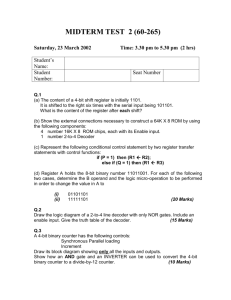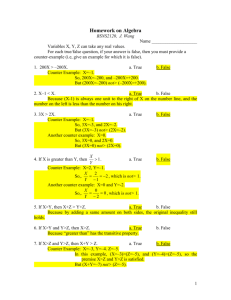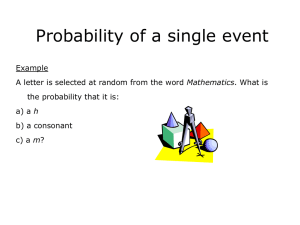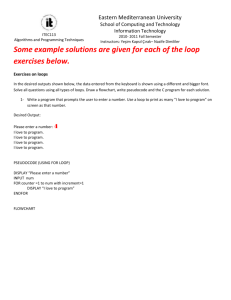33_Solved_Problems - Iowa State University
advertisement
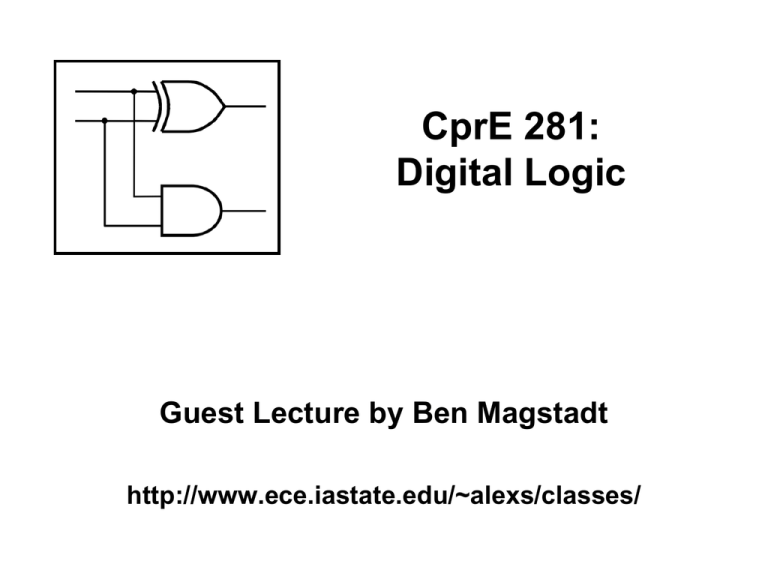
CprE 281: Digital Logic Guest Lecture by Ben Magstadt http://www.ece.iastate.edu/~alexs/classes/ Counters & Solved Problems CprE 281: Digital Logic Iowa State University, Ames, IA Copyright © 2013 Administrative Stuff • Homework 8 is out • It is due on Monday Nov 11, 2013 Other Types of Counters (Section 5.11) A two-digit BCD counter • 2: Parallel-load four-bit counter Figure 5.24 • Each counts in binary 0-9 • Resets generated on 9 Reset by loading 0’s • Second digit enabled by a 9 on first counter A two-digit BCD counter [ Figure 5.27 from the textbook ] N-bit ring counter 1000, 0100, 0010, 0001, 1000……. Reset • Set start to 1 • Sets output to 1000 N-bit ring counter [ Figure 5.28a from the textbook ] 4-bit ring counter Use a 2-bit counter • 00, 01, 10, 11, 00…….. 2-4 Decoder • 1000, 0100, 0010, 0001, 1000…….. 4-bit ring counter [ Figure 5.28b from the textbook ] Johnson Counter 1-bit changes at a time 0000, 1000, 1100, 1110, 1111, 0111, 0011, 0001, 0000 Begin with a reset of all flip-flops Johnson counter [ Figure 5.29 from the textbook ] Reaction Timer Circuit (Section 5.14) Problem Statement • • • • Want to design a reaction timer Circuit turns on light (LED) Person then presses switch Measures time from LED on until the switch is pressed Clock Divider • Input: 102.4kHz • Output: 100Hz • 10-bit Counter to divide • Output Frequency = 102.4k / 2^10 = 100Hz A reaction-timer circuit [ Figure 5.61 from the textbook ] Functionality of circuit Push switch • Nominally 1 DFF to keep track of the state Two-digit BCD counter • Output goes to converters to a 7-segment display Start-up • Assert the Reset signal – Clears counter – Clears flip-flop • Assert w=1 for one cycle • Once switch is hit – Clears flip-flop – Stops counting Push-button switch, LED, and 7-segment displays [ Figure 5.61c from the textbook ] Timing Analysis of Flip-Flop Circuits (Section 5.15) Timing Review • tsu: setup time • th: hold time • tcQ: propogation delay Timing Example • tsu: 0.6ns • th: 0.4ns • tcQ: 0.8ns to 1.0ns Which value to use? • Logic gate delay: 1+0.1k k is equal to the number of inputs • Tmin = tsu + tcQ + tnot = 0.6 + 1.0 + 1.1 = 2.7ns • Fmax = 1/Tmin = 370.37MHz • Check for hold violations Fastest Q can change = tcQ + tnot = 0.8 + 1.1 = 1.9ns 1.9ns > 0.4ns therefore no hold violations Timing Example: 4-bit counter [ Figure 5.67 from the textbook ] Timing Example: 4-bit counter • Look for longest path Q0 to Q3 • • • • Propagation delay of Q0 3 AND propagation delays 1 XOR propagation delay Setup delay for Q3 • Tmin = 1.0 + 3(1.2) + 1.2 + 0.6 = 6.4ns • Fmax = 1/6.4ns = 156.25MHz • Check for hold violations Fastest Q can change = tcQ + tXOR = 0.8 + 1.2 = 2ns 2.0ns > 0.4ns therefore no hold violations Timing Example: Clock Slew Figure 5.68. A general example of clock skew. Slew Timing Example: 4-bit counter • Q3 now has a clock slew delay: 1.5ns T = 1.0 + 3(1.2) + 1.2 + 0.6 - 1.5 = 4.9ns • Now might not be the longest path • Check Q0 to Q2 T = 1.0 + 2(1.2) + 1.2 + 0.6 = 5.2ns • Fmax = 1/5.2ns = 192.31MHz Examples of Solved Problems (Section 5.17) Example 5.18 Figure 5.70. Circuit for Example 5.18. Example 5.19 Figure 5.71. Circuit for Example 5.19. Figure 5.72. Summary of the behavior of the circuit in Figure 5.71. Example 5.20 Vending machine example • Inputs N, D, Q, Coin, Resetn N, D, Q: nickel, dime, quarter Coin: pulsed when a coin is entered • Used to store values into register Resetn: resets the register value to zero • Add up new coin with old value Store new sum into old value register • See if total is above thirty cents If so output Z goes high Circuit for Example 5.20 [ Figure 5.73 from the textbook ] Example 5.22 Faster 4-bit Counter • Want to increase the speed of the 4-bit counter • Use similar method as used in 4-bit adder • Remove series AND gates A faster 4-bit counter [ Figure 5.75 from the textbook ] Faster 4-bit Counter • • • • Longest path: Q0 to Q3 Tmin = tcQ0 + tAND + tXOR + tsu =1.0 + 1.4 + 1.2 + 0.6 = 4.2ns Fmax = 1/4.2ns = 238.1MHz > 156.25MHz Questions? THE END
